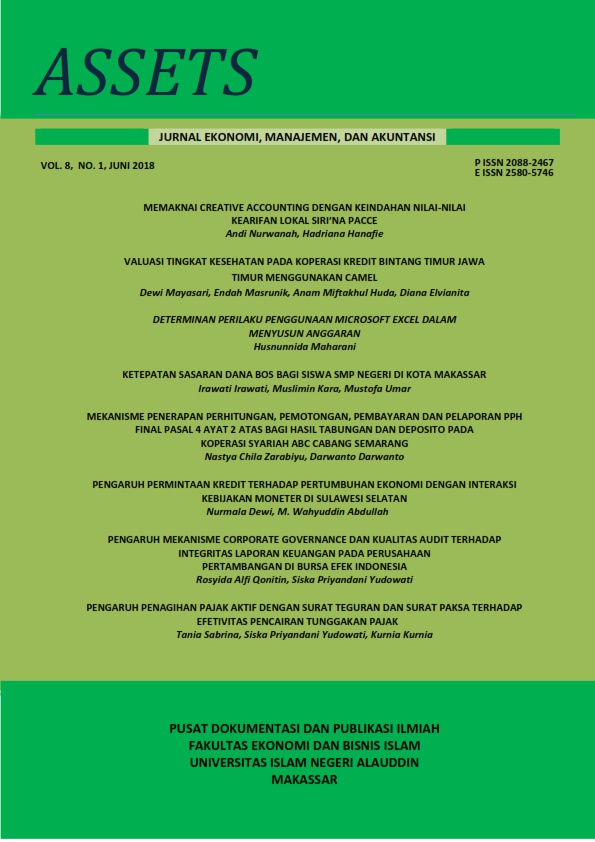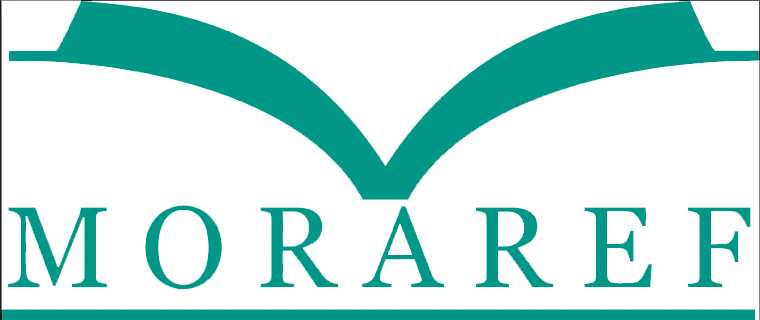DETERMINAN PERILAKU PENGGUNAAN MICROSOFT EXCEL DALAM MENYUSUN ANGGARAN
Abstract
This study aims to examine the factors that influence student behavior in budgeting using Microsoft Excel applications. This study develops model Technology Acceptance Model (TAM) and Theory of Planned Behavior (TPB) by adding self efficiacy variable. The sample used in this study is the accounting students of the International University of Semen Indonesia 6th semester who took the subject of Budgeting as many as 48 respondents. The result of this study is the construct of the positive effect on the behavior of Microsoft Excel usage. Usability, credibility, attitudes, behavioral control, and self-confidence have a positive effect on the interest in using Microsoft Excel. Ease and subjective norms have a negative effect on the interest in using Microsoft Excel. The implication of this study is that the lecturer of the course subject to budgeting should pay more attention to usability, credibility, attitude, behavior control, and self efficacy of student to increase interest in using Microsoft Excel applications in budgeting.References
Abdillah, W. dan Hartono. 2015. Partial Least Square (PLS). CV. Andi Offset, Yogyakarta.
Ajzen, I. 1991. The Theory of Planned Behavior. Organizational Behavior and Human Decision Process Journal, 50(1): 179-211.
Alleyne, P., dan Phillips, K. 2011. Exploring Academic Dishonesty Among University Students in Barbados: An Estension to the Theory of Planned Behavior. Journal of Acad Ethics, 2(9): 323-338.
Azmi, A. C., dan N. L. Bee. 2010. The Acceptance of The Microsoft Excel System by Malaysian Taxpayers: A Simplified Model. Electronic Journal E-Government, 8 (1): 13-22.
Bandura, A. 1999. Social Cognitive Theory: An Agentic Perspective. Journal of Business Ethics, 61 (2): 165-181.
Chang, I. C., Y. C. Li, W. F. Hung, dan H. G. Hwang. 2005. An Empirical Study on The Impact of Quality Antecedents on Tax Payers’ Acceptance of Internet Tax-Filing Systems. Government Information Quarterly, 22(1): 389-410.
Davis, F. D. 1989. Perceived Usefulness, Perceived Ease of Use, and User Acceptance of Information Technology. MIS Quarterly, 13 (5): 319-339.
Davis, F. D., R. P. Bagozzi, dan P. R. Warshaw. 1989. User Acceptance of Computer Techonology: A Comparison of Two Theoretical Models. Management Science, 5 (2): 982-990.
Fu, J. R., C. K. Farn, dan W. P. Chao. 2006. Acceptance of Electronic Tax Filling: A Study of Taxpayer Intentions. Information & Management, 43(1): 109-126.
Hartono, H. M. J. 2007. Sistem Informasi Keperilakuan. CV. Andi Offset, Yogyakarta.
Indriantoro, N. dan Supomo, B. 1999. Metodologi Penelitian Bisnis untuk Akuntansi dan Manajemen. Edisi 1. BPFE, Yogyakarta.
Lam, T., V. Cho, dan H. Qu. 2007. A Study Of Hotel Employee Behavioral Intentios Woward Adption Of Information Technology. Elsevier. International Journal of Hospitality Management, 26 (2): 9-65.
Lee, H. Y., Y.K. Lee, dan D. Kwon. 2005. The Intention To Use Computerized Reservation Systems:The Moderating Effects Of Oganization Support And Supplier Incentive. Journal Of Business Research, 58 (3): 1552-1561.
Lie, I., dan Sadjiarto. 2013. Faktor- Faktor yang Mempengaruhi Minat Mahasiswa untuk Menggunakan Microsoft Excel. Jurnal Tax & Accounting Review, 3 (2): 201-217.
Lu, C. T., S. Y. Huang, dan P. Y. Lo. 2010. An Empirical Study of On-Line Tax Filling Acceptance Model: Integrating TAM and TPB. African Journal of Business Management, 4 (5): 800-810.
Noviandini, N. C. 2012. Pengaruh Persepsi Kebermanfaatan, Kemudahan penggunaan Penggunaan, Dan Kepuasan Mahasiswa Terhadap Penggunaan Microsoft Excel Bagi Mahasiswa Di Yogyakarta. Jurnal Nominal, 1 (1): 14-31.
Pikkarainen, T., K. Pikkarainen, H. Karjaluoto, dan S. Pahnila. 2004. Consumer acceptance of online banking: an extension of the technology acceptance model. Social Behavioral Sciences, 14 (3): 224–235.
Santhanamery, T., dan T. Ramayah. 2012. Continued Usage Intention of Microsoft Excel System in Malaysia: The Role of Optimism Bias. Social Behavioral Sciences, 65 (1): 397-403.
Sniehotta, F., Scholz, U., & Schwarzer, R. 2005. Bridging the Intention Behavior Gap: Planning, Self Efficacy, and Sction Control in the Adoption and Maintenance of Physical Exercise. Psychology and Health Journal, 20 (2): 143-160.
Venkatesh, V. dan F. D. Davis. 2000. A Theoretical Extension Of The Technology Acceptance Model : Four Longitudinal Field Studies. Management Science, 8 (1): 186-199.
Wang, Y. S. 2002. The Adoption of Electronic Tax Filling Systems: An Empirical Study. Government Information Quarterly, 20 (1): 333-352.
Yi, M. Y., J. D. Jackson, J. S. Park, dan J. C. Probst. 2006. Understanding Information Technology Acceptance By Individual Perofessionals: Toward An Intergrative View. Information and Management, 43 (3): 350-363.
Copyright (c) 2018 Assets

This work is licensed under a Creative Commons Attribution-NonCommercial-ShareAlike 4.0 International License.










